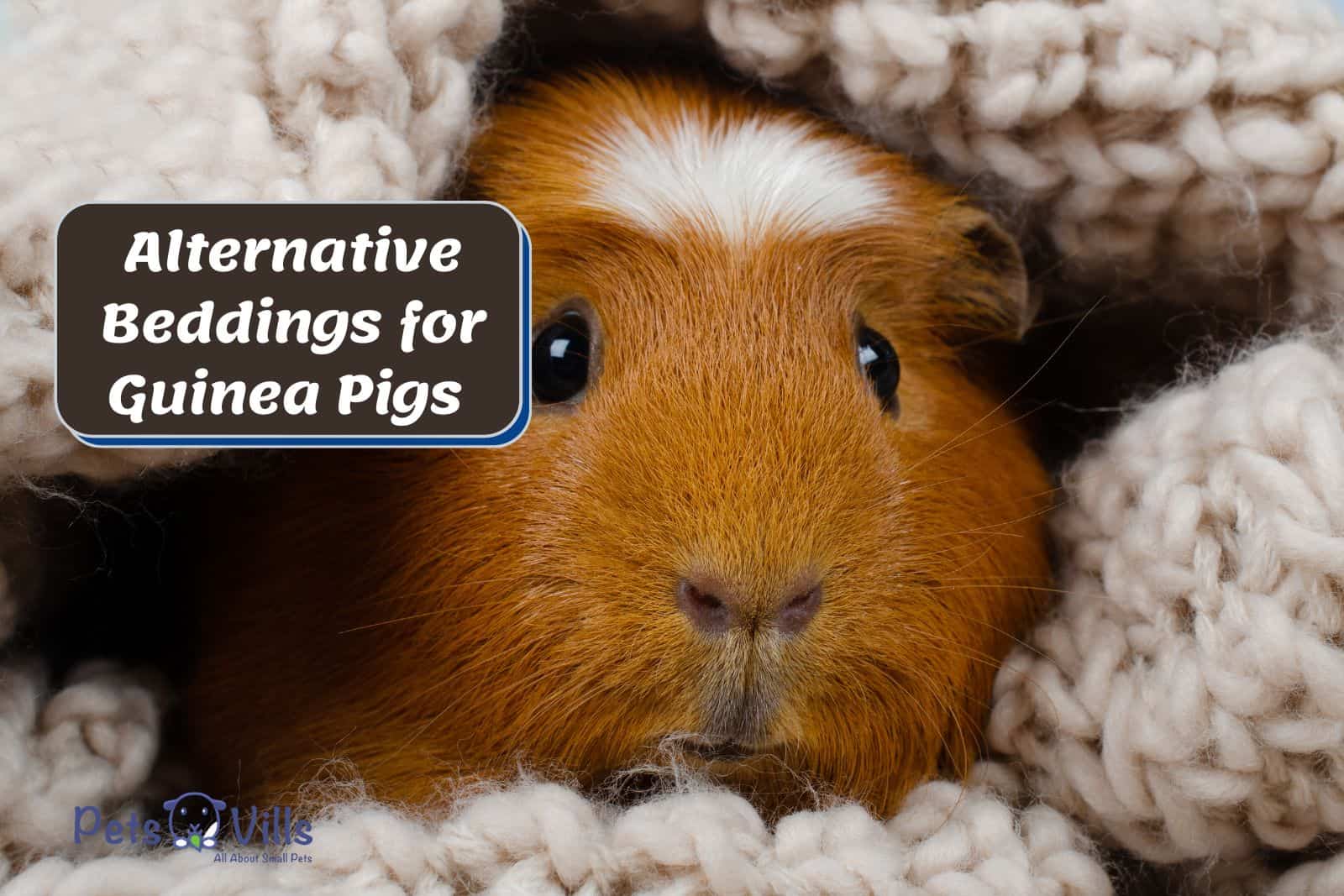Are you looking for alternative bedding for guinea pigs?
When I was a novice cavy owner, I was overwhelmed by all the available DIY bedding options, so I spent a lot of time researching their befits and drawbacks.
And I’m here to share my experience using the best 9 guinea pig bedding alternatives, so you can find the right one for your furry friend.
Just keep reading.
Table of Contents
Quick Summary
- Maintaining cage hygiene is essential for keeping guinea pigs healthy and preventing infectious diseases.
- Some bedding options are dangerous for guinea pigs, and owners should avoid them at all costs.
- Always consider how well the bedding absorbs moisture to ensure a clean cage.
9 Best Alternative Bedding Ideas for Guinea Pigs
Guinea pigs have sensitive skin, fur, and feet, so they need soft bedding which won’t trigger an allergic reaction or harm them if ingested. And clean bedding is vital for disease prevention.
However, commercial bedding can be expensive. And not all commercial products do a good job of absorbing moisture and don’t keep your piggy warm, dry, and happy.
Fortunately, you’ve got plenty of material in your house that you can use to make suitable and safe guinea pig bedding. Keep reading or check my summary table!
| Benefits | Drawbacks | How to Use | |
| Fleece | Soft and cozy Absorbs well Easy to clean Reusable Dust-Free Eco-friendly Available in different colors, patterns, and models | Frequent washing You need to remove hairs and debris before washing Not waterproofed | Suitable as a main bedding It needs changing every week or so |
| Paper | Highly absorbent Controls odor well Easy to find and purchase | DIY paper bedding takes time to make It can be a bit disty Costly in the long run Messy | Suitable for main bedding, but you should make it from clean paper. Wet bedding needs to be replaced every 1-2 weeks. |
| Shredded Cardboard | Soft Easy to use Cheap Eco-friendly | Not all cardboard is safe for guinea pigs Needs frequent changing A bit messy | It’s best as temporal bedding or in combination with other bedding materials. Replace wet bedding every week or so. |
| Wood Shavings | Natural Biodegradable Controls odor well Soft Absorbs well Low in dust | Some types of wood shavings are toxic to guinea pigs Messy Not reusable | Use only kiln-dried shavings marked safe for small animals. Replace shavings weekly or every couple of days if they get |
| Bath Mats | Good absorbent properties Easy to use Soft Reusable Cheap | Not the best odor control Frequent washing You need to remove debris before washing | Great for high-traffic areas Wash and replace every couple of days. |
| Hay | Encourages natural burrowing behavior Easy to find Dust-free Comfortable Cheap Safe if consumed | Not very absorbent Lack of odor control Sharp stalks can hurt guinea pigs’ feet | Lay the cage’s bottom with paper and put a layer of hay over it. Replace weekly. |
| Hemp | Highly absorbent Controls odor well Biodegradable Non-toxic Natural antibacterial properties | Disposable Not suitable for sensitive guinea pigs Messy Not very comfortable | Combine with another soft bedding Replace weekly or as needed. |
| Cotton Towels | Easy to use Absorb well Reusable Soft Available in different colors | No odor control Cotton dust can be harmful to cavies Frequent washing | Use as temporal bedding or combine with your usual bedding for extra absorbency. Replace weekly or every couple of days. |
| Blankets | Easy to use Good absorbency Reusable Cost-effective | No odor control Frequent washing It can be dangerous if consumed | Use as emergency bedding and check that your cavy doesn’t try to it. Replace when wet. |
Here’s a quick video overview:
#1 Fleece Liners
Fleece is a traditional bedding, but it remains one of the best options for cavies, especially for piggies with sensitive feet, skin, and respiratory systems. But let’s see its benefits and drawbacks in detail.
Benefits of Fleece Liners
Fleece is a safe bedding for cavies because it’s soft and dust-free. It won’t hurt your piggy’s feet or trigger an allergic reaction. And my guinea pigs love the soft surface!
Moreover, fleece liners have an absorbent layer that wicks moisture and doesn’t allow it to build in the cage. And fleeces come in different colors, patterns, and models.
Even better, you can make fleece cage liners yourself, so you don’t have to buy them. You’ll see how in a minute.
And fleece liners are reusable, so they’re an excellent choice to save money in the long run. Best of all, since fleece is colorfast, you can use bleach and vinegar to kill bacteria and germs.
I also like using fleece because it’s better for the environment since it doesn’t produce as much waste as shavings or paper.
Drawbacks of Fleece
While fleece is easy to maintain, you can’t just toss it in the washing machine. Since poop, hairs, and other debris tend to stick to the surface, you must remove them before cleaning the bedding.
Moreover, fleece bedding needs a couple of washes before it reaches maximum absorbent power. And you can’t use fabric softeners with it.
If you’re considering using fleece as guinea pig bedding, be sure to check out my guide on “How to Use Fleece as Guinea Pig Bedding.” This article provides step-by-step instructions for preparing and maintaining fleece bedding for furry friends.
How to Make Fleece Bedding
To make one fleece liner, you need two pieces of fleece, an absorbent pad, and a sewing machine:
- Measure the cage size – length and width – and add an inch to both measurements. Then cut two pieces of fleece.
- Assemble the fleece liner. Place the top fleece piece right side up, then the bottom piece right side down. The absorbent pad is last with the absorbent side up.
- Sew the pieces, leaving an opening to flip the fabric. This way, the absorbent layer goes in the middle, where it should be.
- Once you have flipped the fabric, sew the opening. Then the bedding is ready for use.
- I recommend making at least two fleece liners so you always have fresh bedding to use.
- Watch this video to learn how to make waterproof fleece pads for your guinea pig’s cage.
#2 Paper
Paper is another bedding option for guinea pigs. However, not all paper is a great choice for cavies – it should be scent-free without sharp edges.
Benefits of Paper Bedding
Paper is an excellent absorbent material that can soak urine with no problems. And it has outstanding odor control abilities, so you don’t have to worry about a stinking cage.
As vets from VCA explain, “Shredded newspaper or commercially available recycled paper products make the best bedding, as they are safe if ingested and are not dusty or irritating to the respiratory tract.” (1)
I also like paper bedding because it’s soft and comfortable, especially for guinea pigs with sensitive feet. And it can last up to a week without changing.
Guinea pigs love paper because they can burrow, scratch, and play in it. And using recycled paper is a great way to reduce your pet’s carbon footprint.
Drawbacks of Paper Bedding
Cleaning shredded paper is not as easy as tossing fleece bedding into the washing machine. You have to scoop it out of the cage, and guinea pigs can kick it out of the enclosure.
Moreover, commercial paper beddings have a high cost in the long run because you have to replace them every two weeks.
On the other hand, DIY paper beddings are cost-free, but it takes time to prepare them. And chemically-treated paper can be a danger to your piggies’ health.
Some types of paper are also dusty. That’s bad because it’s easy for guinea pigs to get a respiratory infection from dusty bedding.
How to Make Paper Bedding
To make paper bedding for guinea pigs, follow the below steps:
- Take a few clean sheets of paper and cut them into strips with no sharp edges
- Place the shredded paper into a bowl of warm water and wait for it to soak.
- Scrunch the paper into a ball and squeeze as much water as possible.
- Put the paper ball into a plastic container and wait for it to dry.
- When the paper is completely dry, break it into small pieces and place it inside your guinea pig’s cage.
Watch this video for a demonstration:
#3 Shredded Cardboard
Cardboard is also an excellent disposable bedding for cavies. It’s safe, cost-saving, and eco-friendly. But let’s see what its main benefits and drawbacks are.
Benefits of Cardboard Bedding
Guinea pigs tend to snack on whatever bedding you put in the cage. And since cardboard is made of paper, it’s not dangerous for cavies to gnaw it.
Cardboard also has excellent absorbent abilities, keeping the cage dry. It’s also cheap, soft, and easy to use.
Drawbacks of Cardboard Bedding
Some shipping boxes have glue and other chemicals that harm your cavies’ health. So, you have to be careful what boxes you use for bedding.
Moreover, cardboard doesn’t have the same odor control as traditional bedding, so you may have to change it frequently to avoid unpleasant smells.
How to Make Cardboard Bedding
It’s easy to use cardboard in guinea pig cages:
- Pick a cardboard box and clean it well to remove any chemical residue. Get rid of any labels or parts that contain ink.
- Tear the cardboard by hand and ensure there are no sharp edges.
- Place it in the cage and replace it every couple of days.
If you’re a guinea pig owner or thinking of becoming one, be sure to check out my articles on the best bedding for guinea pigs, the best guinea pig litter box, and whether can you potty train a guinea pig. These articles provide helpful tips and insights to keep your guinea pig happy and healthy.
#4 Wood Shavings
Wood shavings are among the traditional bedding options for guinea pigs. However, pet owners should remember a few things when using shavings. But firsts, let’s talk about their benefits.
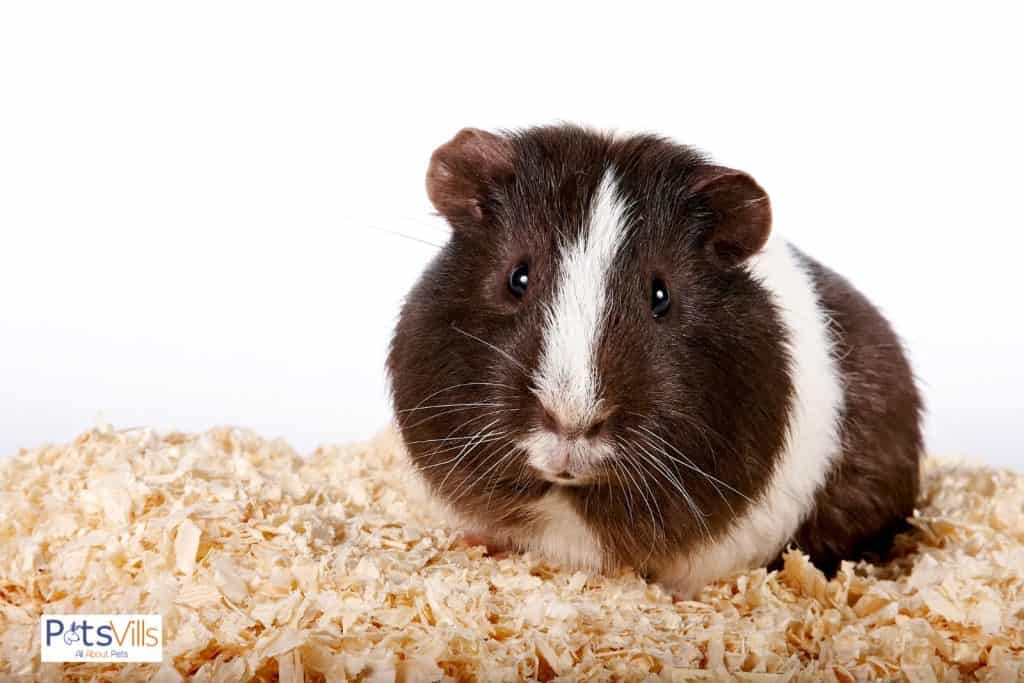
Benefits of Wood Shavings
Shavings absorb animal urine well, so they’re perfect for small pets, such as guinea pigs. And pine shavings have a natural aroma that’s great for controlling odors.
Best of all, shavings are soft on the paws, and dust-free brands ensure your guinea pigs aren’t in danger of respiratory problems.
Drawbacks of Wood Shavings
Wood shavings are a controversial bedding for guinea pigs because some wood types contain toxic oils for small animals. And they have to go through a special process to make them safe.
In general, kiln-dried pine shavings are safe for guinea pigs. However, I recommend aspen shavings since they don’t contain any dangerous chemicals.
Guinea Lynx also notes, “And if you’re using pine, be sure to air the shavings thoroughly and use in a well-ventilated cage. Airing the shavings will allow the volatile oils to dissipate.” (2)
Moreover, shaving bedding can be messy, and you must replace it every week.
Can You Make Wood Shaving Bedding at Home?
I don’t recommend trying to make wood shavings at home. You can pick wood material toxic to guinea pigs or processed with harmful chemicals.
Fortunately, you can find wood shavings for guinea pigs in plenty of pet stores.
#5 Bath Mats
You can use bath mats if you’re looking for simple reusable bedding for your cavies. They have a few pros, but they’re not my first choice when looking for alternative bedding for guinea pigs.
Benefits of Bath Mats
Mats are easy to use, cheap, and handy when you run out of your usual bedding. Unlike fleece, they’re also designed to absorb water, so you don’t have to break them in.
Moreover, you can wash mats in the washing machine by adding mild detergent and vinegar to kill germs. And they’re cost-efficient in the long run.
Best of all, bath mats are durable, light, and soft. My guinea pigs love the texture, and I can easily move the cage whenever I clean it.
Drawbacks of Bath Mats
If you’re using mats, don’t expect miracles regarding odor control. You must also pick hairs and debris off the mat before washing it.
How to Use Bath Mats as Guinea Pig Bedding?
First, measure your guinea pig cage and cut the mat to the appropriate size. Then place the rug in high-traffic areas. Remove debris and food debris daily.
#6 Hay
Specialists from RSPCA explain, “Guinea pigs need hay and/or grass for their digestive systems to function properly.” (3)
So, since hay should be part of your piggy’s diet, can you use it as bedding? Yes, you can!
Benefits of Hay Bedding
- Guinea pigs love sleeping in the hay!
- Using hay as bedding encourages natural behaviors, such as foraging.
- Easy to find in pet stores
- Inexpensive compared to commercial guinea pig bedding.
- Soft, comfortable, and dust-free
- Eco-friendly because you can compost it afterward
Drawbacks of Hay Bedding
- Hay doesn’t absorb as well as other alternatives,
- You’ll need to replace the dirty bedding often.
- Cleaning is also messy since hay stalks can get all over your house.
- Rough hay has sharp ends, so it’s not best for piggies with wounds or sensitive skin.
How to Use Hay as Bedding?
Place clean papers on the bottom of your guinea pig’s cage. Then put a layer of hay on the top to make a comfortable sleeping/playing surface.
Don’t substitute hay with straw. Straw has sharper stalks than hay and can hurt your cavy’s feet, skin, and eyes. And it has little nutritional value for your furry friend.
#7 Hemp Bedding
Hemp is a popular bedding for horses because of its excellent absorbent properties. But is it suitable for small pets, such as guinea pigs? The short answer is yes!
Interestingly, hemp is naturally resistant to many pests, so manufacturers don’t have to use pesticides. And the plant grows very quickly, so it’s more sustainable than paper or wood.
Benefits of Hemp
- Reusable and sustainable
- No toxic aromatic oils
- Low in dust
- Natural antibacterial and antifungal properties
- Absorbent
- Excellent odor control
Drawbacks of Hemp
- Not as cozy as other traditional bedding types
- Not suitable for hairless guinea pigs or ones with sensitive skin
- A bit messy
- Disposable, so you need to buy it regularly
How to Use Hemp As Alternative Bedding for Guinea Pigs?
Since hemp isn’t as soft as other guinea pig bedding, you should consider adding hay or other soft material in your piggy’s sleeping hideout.
Clean the cage regularly, and replace the bedding weekly. You can compost the dirty bedding or throw it in the appropriate trash bin.
#8 Cotton Towels
Thin, soft cotton towels are among the suitable bedding options for guinea pigs. They’re safe, cheap, and comfortable.
Benefits of Cotton Towels
- Reusable and easy to maintain
- Cotton has great absorbent properties
- Suitable for guinea pigs with sensitive fur
- Available in a wide variety of colors, patterns, and sizes
- It needs washing every 1-2 weeks
Drawbacks of Cotton Towels
- According to some studies, frequent exposure to cotton dust can lead to respiratory infections in guinea pigs. (4)
- Not the best odor control
- Guinea pigs may eat cotton threads
How to Use Cotten Towels as Guinea Pig Bedding?
Since cotton towels get dirty quickly, it’s best to use them as temporary bedding when you run out of other options. Or you can use them under your usual bedding for an extra absorbent layer.
#9 Blankets
Blankets are another guinea pig bedding option. They’re soft, comfortable, absorbent, easy to use, wash, and clean.
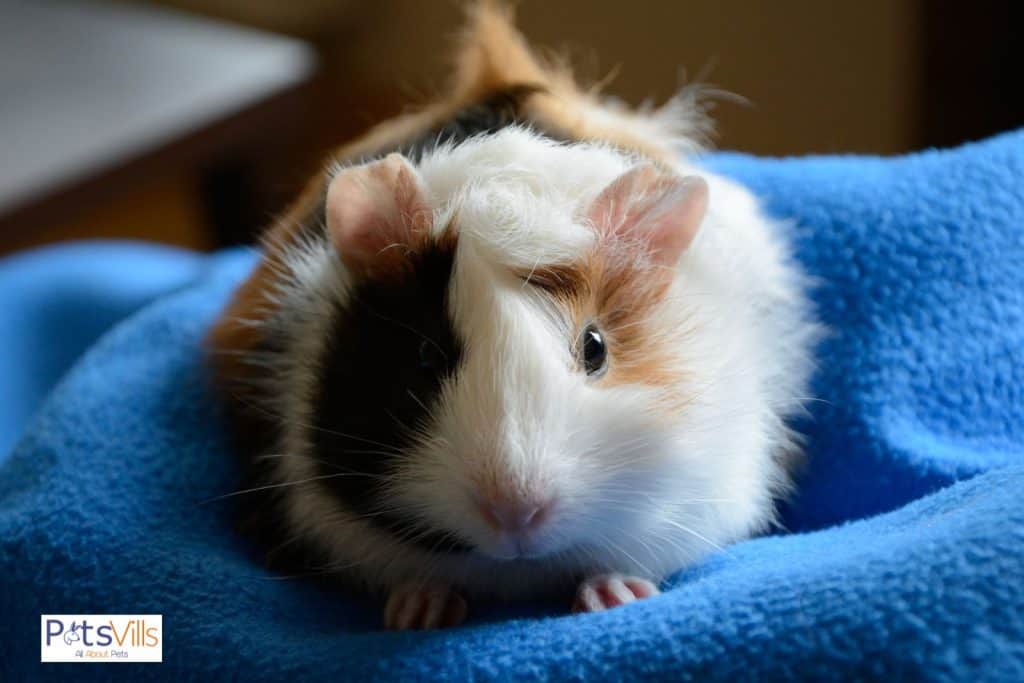
Benefits of Blanket Bedding
- Suitable for cavies with sensitive fur
- Absorbs urine relatively well
- Reusable
- Cost-effective
Drawbacks of Blanket Bedding
- No odor control
- It can be dangerous if guinea pigs eat the fabrics
How to Use Blanket Bedding for Guinea Piggies?
Using blankets is easy – measure the cage size and find a blanket with a similar size or cut the fabric. Remove debris and poop daily and wash every couple of days.
While you’ve got plenty of alternative bedding for guinea pigs, some materials aren’t suitable and can be dangerous for your piggies’ health. Let’s see them!
3 Dangerous Beddings for Guinea Pig Bedding
Whenever I try new bedding, I always research online to ensure it doesn’t contain anything harmful to my piggies. So, here are my top three bedding types to avoid.
#1 Cat Litter
Cat owners know what cloud of dust most litter brands produce when you pour it into the litter box. So, kitty litter can cause respiratory problems.
Moreover, litter consists of sharp pebbles, which can hurt a guinea pig’s sensitive paws. And if your piggy eats some of the litter, it can cause an intestinal blockage.
I also don’t recommend natural cat litter made from paper or wood. They may contain chemicals or ingredients toxic to guinea pigs.
#2 Some Types of Wood Shavings
I already mentioned that pine shavings are a bit controversial bedding because of their aromatic oils. So, you want to avoid those pine shavings that aren’t kiln-dried to remove the harmful substance.
Moreover, you shouldn’t use cedar shavings. They produce a dangerous smell when wet and can cause respiratory problems.
#3 Corn Cob
Guinea pigs can eat corn cob, but it’s not suitable for bedding. Corn cob is prone to mold and can be dangerous for your cavies if ingested.
Moreover, corn cob has sharp edges that can hurt your guinea pigs’ feet. And the pieces are small enough to get stuck in your piggies’ anal or genital area.
And now, let’s talk about how to choose alternative bedding for your guinea pig.
How to Choose the Best Alternative Bedding for Guinea Pigs?
When looking for alternative bedding for guinea pigs, you should consider a couple of things to ensure you get the right one.
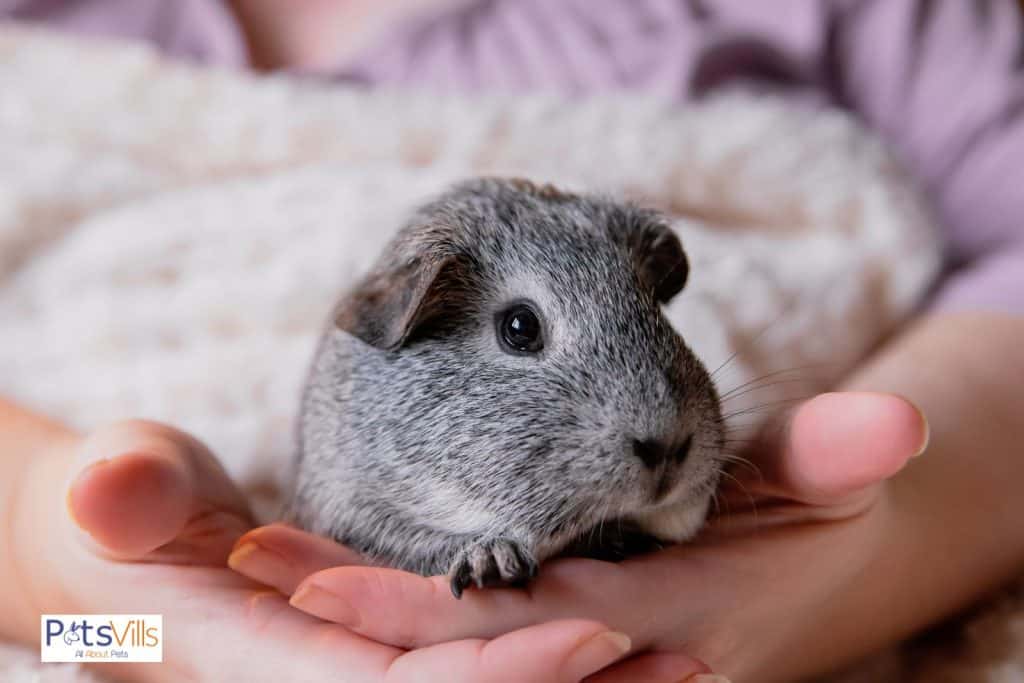
Disposable vs. Reusable
Disposable bedding is easy to maintain because you throw it out when dirty. Reusable ones, such as fleece, you must wash them every couple of days.
But disposables are more expensive in the long run and can be hard to clean off the cage’s floor.
Absorbency
Not all guinea pig bedding options absorb urine equally. Some can last a week or more, while you must replace others every few days.
Free of Chemicals
Whatever bedding you choose, it should be chemical-free. Newspapers and other paper items with inks are unsafe. Scented bedding is also likely to cause problems for your guinea pig.
Also, remember that cavies snack on their bedding, so the material should be something non-toxic and not likely to cause intestinal blockage.
FAQs
1. Can guinea pigs go without bedding?
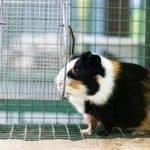
Guinea pigs can’t go without bedding, especially in mesh or wire cages. Cavies have sensitive feet and need soft and comfortable bedding to prevent painful injuries.
2. What is the cheapest way for guinea pig bedding?
Aspen bedding is one of the cheapest options for guinea pig owners. Fleece is also cost-effective since it’s reusable.
3. Can I use toilet paper as guinea pig bedding?
Yes, you can use toilet paper as an emergency guinea pig bedding. But don’t use it often because toilet paper doesn’t absorb urine well.
Conclusion
You don’t have to use commercial guinea pigs bedding because you’ve got plenty of cheaper alternatives with excellent absorbent properties.
Fleece is my favorite because I can toss it in the washing machine, but paper bedding is also great for keeping the cage clean and smell-free.
Consider whether you’re willing to handle wet and dirty bedding in your washing machine or want something you can throw out and replace to make your final choice.
What do you think about these nine alternative bedding for guinea pigs? Which one is your favorite guinea pig bedding alternative? Share your experience with us!
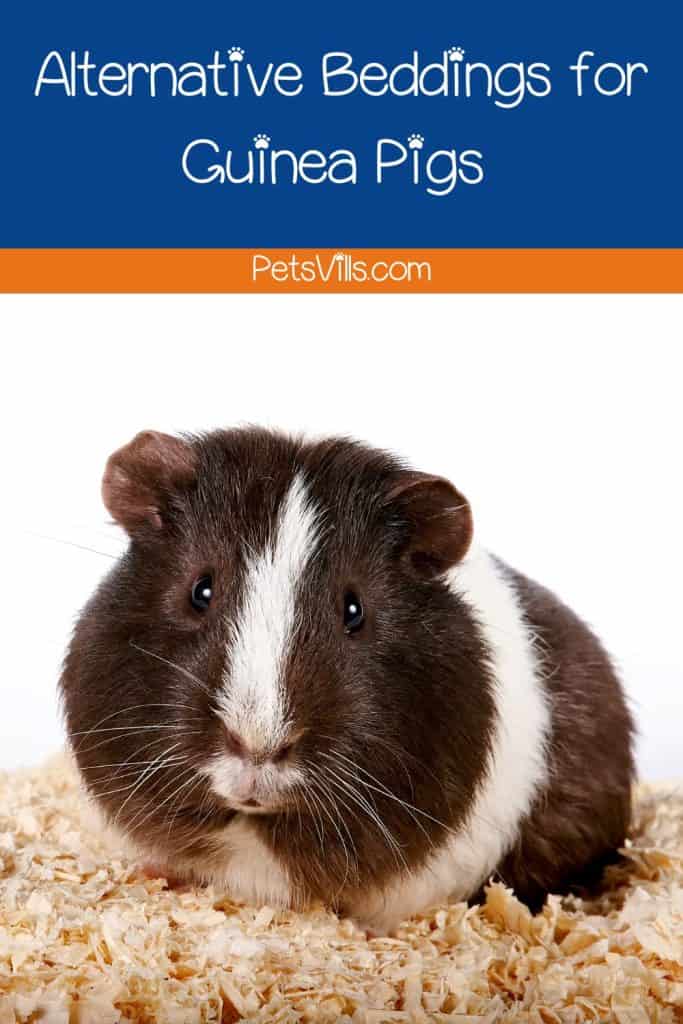
Resources:
1. Owning Guinea Pigs [Internet]. vca_corporate. Available from: https://vcahospitals.com/know-your-pet/guinea-pigs-owning
2. Guinea Lynx :: Beddings to Avoid [Internet]. www.guinealynx.info. [cited 2023 Apr 10]. Available from: https://www.guinealynx.info/bedding_avoid.html
3. RSPCA. Diet – Guinea Pigs – Our pets [Internet]. Rspca.org.uk. 2017. Available from: https://www.rspca.org.uk/adviceandwelfare/pets/rodents/guineapigs/diet
4. Ellakkani MA, Alarie Y, Weyel D, Karol MH. Chronic pulmonary effects in guinea pigs from prolonged inhalation of cotton dust. Toxicology and Applied Pharmacology [Internet]. 1987 [cited 2023 Apr 10];88:354–69. Available from: https://pubmed.ncbi.nlm.nih.gov/3107166/

My name is Ben Roberts, and I absolutely love animals. So, naturally, I love writing about them too! As far as my animals, I have a Pit-bull, a Beagle-lab mix, a Chihuahua, and one old cat. Each one of them provides me with a new adventure every day. And the best part is they’re all best friends. Well, except the cat when he gets a little annoyed.
FIND HIM ON: FACEBOOK and TWITTER.
Read his latest ARTICLES
Learn more about Benhere

